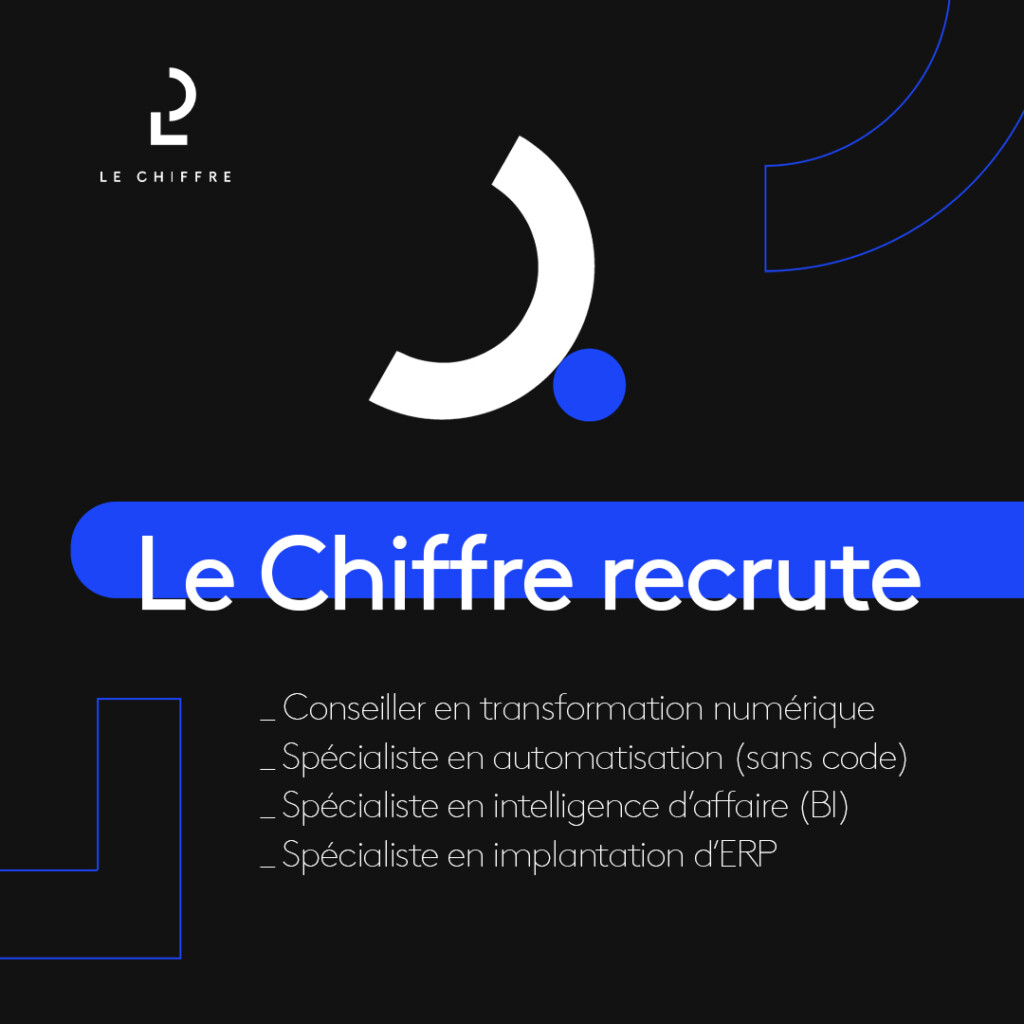Sans code ni gluten
Rédigé le 14 mars 2022

Tambours et trompettes! Nous ouvrons 4 nouveaux postes dans notre équipe transformation numérique, doublant l’équipe actuelle, afin d’augmenter notre impact sur l’automatisation de processus en PME.
Se basant sur notre expertise existante, soit celle d’intégration de systèmes financiers cloud, et devant les besoins grandissants de nos clients, qui jonglent avec une multitude d’applications et de processus désalignés, nous avons décidé de pousser notre intervention plus loin.
Nous recrutons donc 4 postes :
- Conseiller en transformation numérique
- Spécialiste en automatisation (sans code)
- Spécialiste en intelligence d’affaire (BI)
- Spécialiste en implantation d’ERP

Qu’est-ce que le Sans Code?
C’est textuellement ce que ça dit, l’objectif est de programmer des parcours de données sans même toucher à du code, afin de régler des problématiques d’affaires concrètes rapidement et à moindre coût à moyen/long terme, dans l’attente d’une solution qui demande de la « véritable » programmation. D’ailleurs la firme de recherche et de conseils en technologie Gartner prédit que 80% des tâches technologiques seront réalisées par des personnes non spécialisées d’ici 2024.
J’ai un ami développeur qui m’a déjà dit qu’il adorait lorsque ses clients lui présentaient un fichier Excel à coder vers quelque chose de plus robuste et intégré, puisque les règles d’affaires étaient déjà bien établies.
De la programmation sans code, c’est un peu ça, c’est dessiner des parcours pour exploiter les logiciels en vente libre, qui exposent déjà leurs API et rendent possibles des imports de masse, sans nécessairement investir des dizaines de milliers dans de la programmation sur mesure.
Nous le faisons pour nous même :
- Un questionnaire web (Typeform) a récemment remplacé une grille Excel pour nos clients en impôt du particulier.
- Notre logiciel de sondages clients (InputKit) est programmé avec notre logiciel de facturation (Xero), qui lui est déjà lié à un logiciel de gestion de proposition (Practice Ignition)
- Le prélèvement de plus de 250 clients se fait automatiquement avec un logiciel (Rotessa), connecté avec notre système comptable (Xero).
Quelles sont les applications utilisées pour faire du Sans Code?
Il y en a des milliers, et il serait suicidaire de les connaître toutes, si bien que nous choisissons avec soin nos armes et l’expertise que nous développons. Donnons des exemples concrets d’une liste qui cherche quand même à s’allonger :
- Systèmes comptables (Xero, QBO)
- Gestion des dépenses (Dext, Plooto, Expensify)
- ERP (Dear Inventory)
- Paie (Employeur D, Nethris)
- Facturation et gestion de projet (Harvest, Practice Ignition)
- Tableaux de bord, modélisation et fonds de roulement (Futrli, G-Accon)
- Intelligence d’affaires (Power BI, Google Data Studio)
- Connectivité et automatisation (Zapier)
- Communication (Slack, Teams, Google Chat)
- Gestion documentaire sécurisée (Sharepoint)
- Commerce électronique (Shopify, Woo Commerce)
- Collection automatisée (Rotessa, Stripe, Chargebee, Recurly)
- Formulaires (Typeform, MS Form, Inputkit)
Dans quel contexte s’applique cette méthode
Généralement, cette approche s’applique mieux aux entreprises de plus de 10 employés, qui connaissent des enjeux récurrents tels que ceux-ci :
- Manque de visibilité financière des différents intervenants
- Beaucoup de temps passé en actions manuelles
- Manque d’assurance dans l’exactitude des données
- Délais importants dans des activités-clés comme la facturation, la collection des comptes-clients, le paiement des fournisseurs, le paiement des comptes de dépenses et les rapports financiers.
Nous recherchons principalement des gens avec un fort caractère analytique, qui ont la capacité de « voir le chemin », c’est-à-dire de conceptualiser les étapes nécessaires à amener un intrant numérique à un extrant digeste. Vous aurez la chance de travailler dans une équipe comportant déjà les 4 pogos les plus dégelés de notre boîte, pouvant partager des années d’expérience dans la transformation numérique d’entreprises.

« Jamais l’imaginaire n’a été aussi accessible. La créativité étant de moins en moins freinée par les limitations technologiques, il suffit de laisser l’espace aux esprits les plus vifs et déterminés à innover. »
– Pat, grand maître de la transformation numérique et intolérant au gluten (il fallait bien faire un rappel au titre quelque part)
C’est par ici!: https://www.lechiffre.ca/emplois/


